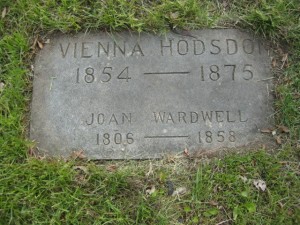
The truth of the revisionist history stories of who was buried first and who is buried where is that Vienna Hodsdon and her grandmother, Joan Wardell, were buried in Lot 101, Block B, in the far southeast corner of the cemetery in 1875 and 1858, respectively. The first burial at Layman”'s Cemetery now called Pioneers and Soldiers Cemetery was 1853.
By Sue Hunter Wier
Uncle Peter first? Joan Wardwell second?, all at Hodsdon”'s at Bloomington and Lake Farm next to Layman”'s
In the late 19-teens and early 1920s several newspaper articles claimed that “Uncle” Peter Wardell (sometimes Wardwell or Waddell) was the second (or even the first) person buried in Minneapolis Pioneers and Soldiers Memorial Cemetery. He was buried, so the stories go, either under what is now the bus stop at Cedar Avenue and Lake Street or in the far southeastern corner of the cemetery at Lake Street and 21st Avenue. Supposedly, Uncle Peter was an employee of Martin Layman who had moved to Minnesota with members of the Layman family in 1853. There”'s only one problem””“Uncle” Peter didn”'t exist.
The confusion about this imaginary man is understandable, though. There is a person with a similar name who was among the earliest burials in the cemetery. Her name was Joan Robbins Wardwell. Mrs. Wardwell died from cancer in 1858, supposedly the first recorded case of cancer in Minneapolis. Although one of her granddaughters claimed that Mrs. Wardwell was the second person buried in the cemetery, that isn”'t true either””there were at least two dozen people buried in the cemetery before she was. What is true is that her husband, George Wardwell, worked for Martin Layman, the cemetery”'s original owner. George Wardwell surveyed the section of Layman”'s farmland that became the first municipal cemetery on the west side of the river. In return, he was given two burial plots.
The Wardwells moved to Minnesota to live with their daughter, Jane Hodsdon. Jane and her husband, Ebenezer, were among the earliest of the transplanted New Englanders to settle in Minneapolis. Their farm was located at what is now Bloomington Avenue and Lake Street. Their nearest neighbors were Martin and Elizabeth Layman.
Joan Wardwell found life in Minnesota difficult. She hated the long, cold winters, and she was lonely. There was little social life to speak of, and the Hodsdon”'s farm was considered a good day”'s drive from “downtown.” She began to complain of stomach pains and was examined by the town”'s two doctors who concluded that she had cancer. There was nothing that they could do for her and she died soon after. Her husband, George, returned to Maine to live with his oldest daughter.
Joan Wardwell”'s granddaughter, Vienna (“Vi”) Hodsdon, is buried in the second grave that the family owned in the cemetery. Vienna was born in Minnesota in 1854, the fourth of Jane and Ebenezer Hodsdon”'s eleven children. Vienna was described by one of her nieces as “the beauty of the family, with curly auburn hair and dark blue eyes.” She worked as a model in a hair-dressing shop until she was diagnosed with “consumption” (tuberculosis). She was 21 years old when she died.
Joan Wardwell and her granddaughter, Vienna Hodsdon, are buried in Lot 101, Block B, in the far southeast corner of the cemetery.
*Turn-of-the-century burlesque sketches used plays on words and names. Examples are “The Baker Scene” (the shop is located on Watt Street) and “Who Dyed” (the owner is named Who). In 1930 movie Cracked Nuts, comedians Bert Wheeler and Robert Woolsey examine a map of a mythical kingdom with dialogue like this: “What is next to Which.” “What is the name of the town next to Which?” “Yes.” In English variety halls (Britain”'s equivalent of vaudeville theatres), comedian Will Hay performed a routine in the early 1930s (and possibly earlier) as a schoolmaster interviewing a schoolboy named Howe who came from Ware but now lives in Wye. By the early 1930s, a “Baseball Routine” had become a standard bit for burlesque comics across the United States. Who”'s on First? is a vaudeville comedy routine made most famous by Abbott and Costello. In Abbott and Costello”'s version, the premise of the routine is that Bud Abbott is identifying the players on a baseball team to Lou Costello, but their names and nicknames can be interpreted as non-responsive answers to Costello”'s questions. In this context, the first baseman is named “Who”; thus, the utterance “Who”'s on first” is ambiguous between the question (“which person is the first baseman?”) and the answer (“The name of the first baseman is ”˜Who”'”).
First Base: Who
Second Base: What
Third Base: I Don”'t Know
Left field: Why
Center field: Because
Picher:: Tomorrow
Catcher:: Today
Shortstop:: I Don”'t Care/I Don”'t Give a Darn/I Don”'t Give a Damn . The name of the shortstop is not given until the very end of the routine, and the right fielder is never identified.










I enjoyed reading this and I have some additional information on the Wardwell family plus a correction or two on this article. Joanna’s husband was named Ebenezer, not George, according to both ancestry.com and census records from 1850 and 1860. I think the son-in-laws name was Hodgson.
I
would love to know if there is a local source of their family history as I am helping to write a history of the Seward Neighborhood and the Wardwell’s owned a big chunk of it.
Marilyn